การพัฒนารูปแบบการดูแลต่อเนื่องสำหรับผู้ป่วยจิตเวชในชุมชน ที่ได้รับบริการสุขภาพจิตทางไกล
คำสำคัญ:
รูปแบบการดูแลต่อเนื่อง, ผู้ป่วยจิตเวชในชุมชน, สุขภาพจิตทางไกลบทคัดย่อ
ปัจจุบันมีการนำบริการสุขภาพจิตทางไกลมาใช้ในการดูแลผู้ป่วยจิตเวช เพื่อส่งเสริมการเข้าถึงบริการ และแก้ไขปัญหาการรักษาไม่ต่อเนื่อง แต่ยังพบข้อจำกัดในการดำเนินงาน การวิจัยครั้งนี้เป็นการวิจัยและพัฒนา เพื่อพัฒนาและตรวจสอบคุณภาพรูปแบบ การดูแลต่อเนื่องสำหรับผู้ป่วยจิตเวชในชุมชนที่ได้รับบริการสุขภาพจิตทางไกล การวิจัยแบ่งเป็น 3 ระยะ ดังนี้ 1) ศึกษาสถานการณ์การบริการสุขภาพจิตทางไกล กลุ่มตัวอย่างคือพยาบาลวิชาชีพ จำนวน 14 คน เครื่องมือวิจัย ได้แก่ แบบบันทึกผลการสนทนากลุ่ม 2) พัฒนาและตรวจสอบคุณภาพรูปแบบการดูแลต่อเนื่องสำหรับผู้ป่วยจิตเวชที่ได้รับบริการสุขภาพจิตทางไกล และ 3) ประเมินผลการใช้รูปแบบที่พัฒนาขึ้น กลุ่มตัวอย่าง ประกอบด้วย พยาบาลวิชาชีพ จำนวน 10 คน และผู้ป่วยจิตเวชจำนวน 90 คน ประกอบด้วย แบบประเมินความสามารถในการดูแลตนเอง แบบประเมินความร่วมมือในการรับประทานยา และแบบประเมินคุณภาพชีวิต วิเคราะห์ข้อมูลโดยสถิติเชิงพรรณนา การทดสอบไคสแควร์ และสถิติทดสอบที ผลการวิจัย พบว่า รูปแบบที่พัฒนาขึ้น ประกอบด้วย แนวทางการพัฒนาศักยภาพบุคลากรสุขภาพ และแนวปฏิบัติการดูแลต่อเนื่องผู้ป่วยจิตเวช ส่วนผลการใช้รูปแบบ พบว่า 1) ความสามารถในการดูแลตนเอง ในด้านภาวะสุขภาพจิต ด้านการรับประทานยา และด้านสัมพันธภาพในครอบครัว ในกลุ่มที่ใช้รูปแบบสูงกว่ากลุ่มควบคุม อย่างมีนัยสำคัญทางสถิติ (p<.05)
2) ความร่วมมือในการรับประทานยาในกลุ่มที่ใช้รูปแบบสูงกว่ากลุ่มควบคุม อย่างมีนัยสำคัญทางสถิติ (p<.001) และ
3) คุณภาพชีวิตในกลุ่มที่ใช้รูปแบบกับกลุ่มควบคุมไม่แตกต่างกัน ดังนั้นจึงควรนำรูปแบบที่พัฒนาขึ้นไปใช้อย่างต่อเนื่องและขยายผลไปสู่การบริการสุขภาพจิตทางไกล เพื่อส่งเสริมความสามารถในการดูแลตนเอง และความร่วมมือในการรับประทานยา
เอกสารอ้างอิง
กมนต์ภรณ์ สุวรรณทวีมีสุข, กิติิพล นาควิโรจน์ และ ธัญญรัตน์ โนมัยสินทวี. (2566). ผลลัพธ์ของการใช้ระบบแพทย์ทางไกลควบคู่กับการดูแลปกติเปรียบเทียบกับการดูแลแบบปกติในผู้ป่วยมะเร็งที่ได้รับการดูแลแบบประคับประคอง: การทดลองสุ่มแบบมีกลุ่มควบคุม. วารสารระบบบริการปฐมภูมิและเวชศาสตร์ครอบครัว, 6(2), 133-143.
กรมสุขภาพจิต. (2560). คู่มือการดูแลผู้ป่วยโรคจิตเภท สำหรับโรงพยาบาลในเขตสุขภาพ ฉบับพยาบาล/นักวิชาการสาธารณสุข. จาก https://mhso.dmh.go.th/fileupload/202002061595902378.pdf
กรมสุขภาพจิต. (2565). แนวทางการบริการตรวจรักษาจิตเวชทางไกล (telepsychiatry) ผู้ป่วยนอก: สำหรับสถาบัน/โรงพยาบาลจิตเวช สังกัดกรมสุภาพจิต กระทรวงสาธารณสุข. เข้าถึงได้จาก https://mhso.dmh.go.th/page/subject_details.php?subject_id=734
กองยุทธศาสตร์และแผนงาน กระทรวงสธารณสุข.(2564). รายงานประจำปีกรมสุขภาพจิต ปีงบประมาณ 2564. กรุงเทพ; ละม่อม.
กาญจนา สุทธิเนียม และ ชลพร กองคำ. (2555). การพัฒนาแบบวัดคุณภาพชีวิตของผู้ป่วยจิตเวช สถาบันจิตเวชศาสตร์สมเด็จเจ้าพระยา. วารสารการพยาบาลจิตเวชและสุขภาพจิต, 26(3), 28-40.
ประกาศสภาการพยาบาล เรื่อง แนวทางการพยาบาลทางไกล. (2564, 10 กุมภาพันธ์). ราชกิจจานุเบกษา. เล่ม 138 ตอนพิเศษ 33 ง, หน้า 49-51.
ธนัฎชา สองเมือง และ อนัญญา สองเมือง. (2565). ความร่วมมือในการใช้ยาและการกำเริบในผู้ป่วยจิตเภทหลังถูกส่งตัวรักษาต่อเนื่อง ณ โรงพยาบาลส่งเสริมสุขภาพตำบลใกล้บ้าน. วารสารวิชาการสาธารณสุข, 31(1), 70-79.
รัชนี อุทัยพันธ์. (2555). ผลของการสัมภาษณ์เพื่อเสริมสร้างแรงจูงใจแบบกลุ่มต่อความร่วมมือในการรักษาด้วยยาของผู้ป่วยจิตเภทในชุมชน [วิทยานิพนธ์ปริญญาพยาบาลศาสตร์บัณฑิต]. จุฬาลงกรณ์มหาวิทยาลัย.
วรรณชนก จันทชุม, สมปรารถนา ดาผา, รัชตวรรณ ศรีตระกูล, ศุภลักษณ์ กระแสร์ และ ครุณี ศรีสมบูรณ์. (2563). การพัฒนารูปแบบการสอนงานในการปฏิบัติการพยาบาลของพยาบาลพี่เลี้ยงโรงพยาบาลกรุงเทพขอนแก่น. วารสารการพยาบาลและการดูแลสุขภาพ, 38(1), 157-166.
ศรินรัตน์ จันทพิมพ์ และ ขนิษฐา นันทบุตร. (2561). การดูแลผู้ป่วยจิตเภทโดยชุมชน. วารสารการพยาบาลและการดูแลสุขภาพ, 36(2), 68-76.
สุมิศา กุมลา, โสภิณ แสงอ่อน และ พัชรินทร์ นินทจันทร์. (2563). ผลของโปรแกรมส่งเสริมความร่วมมือในการรับประทานยาในผู้ป่วยจิตเภท. วารสารการพยาบาลจิตเวชและสุขภาพจิต, 34(2), 132-152.
สำนักส่งเสริมและพัฒนาสุขภาพจิต กระทรวงสาธารณสุข. (2559). มาตรฐานการส่งเสริมสุขภาพจิตและป้องกันปัญหาสุขภาพจิตในโรงพยาบาลชุมชน (ฉบับปรับปรุง). นนทบุรี: กระทรวงสาธารณสุข.
American Statistical Association. (2023). G*Power 3.1 manual. Retrieved from https://www.psychologie.hhu.de/fileadmin/redaktion/Fakultaeten/Mathematisch-Naturwissenschaftliche_Fakultaet/Psychologie/AAP/gpower/GPowerManual.pdf
Bradford, N. K., Caffery, L. J., & Smith, A. C. (2016). Telehealth services in rural and remote Australia: a systematic review of models of care and factors influencing success and sustainability. Rural and Remote Health, 16(4), 3808.
Chen, L., Chuang, LM., Chang, CH., Wang, CS., Wang, IC., Chung, Y., ... Lai, F. (2013). Evaluating self-management behaviors of diabetic patients in a tele health care program: longitudinal study over 18 months. Journal of Medical Internet Research, 15(12), e266. doi: 10.2196/jmir.2699
Haggerty, J. L., Reid, R. J., Freeman, G. K., Starfield, B. H., Adair, C. E., & McKendry, R. (2003). Continuity of care: a multidisciplinary review. British Medical Journal, 327(7425), 1219-1221.
Hamann, J., Lipp, M. L., Christ-Zapp, S., Spellmann, I., & Kissling, W. (2014). Psychiatrist and patient responses to suspected medication nonadherence in schizophrenia spectrum disorders. Psychiatric Services, 65(7), 881-887.
Stufflebeam, D. L., & Shinkfield, A. J. (2007). Evaluation theory, models and applications. San Francisco: Jossey-Bass.
Uscher-Pines, L., Arora, N., Jones, M., Lee, A., Sousa, J. L., McCullough, C. M., ... Ober, A. J. (2022). Experiences of health centers in implementing telehealth visits for underserved patients during the COVID-19 pandemic: results from the connected care accelerator initiative. Rand Health Quarterly, 9(4). 2.
Uslu, E., & Buldukoglu, K. (2020). Randomized controlled trial of the effects of nursing care based on a telephone intervention for medication adherence in schizophrenia. Perspectives in Psychiatric Care, 56(1), 63–71. doi: 10.1111/ppc.12376
World Health Organization: WHO. (2019). Recommendations on digital interventions for health system strengthening. Retrieved from https://www.who.int/publications/i/item/9789241550505
ดาวน์โหลด
เผยแพร่แล้ว
รูปแบบการอ้างอิง
ฉบับ
ประเภทบทความ
สัญญาอนุญาต
ลิขสิทธิ์ (c) 2023 วารสารวิจัยการพยาบาลและสุขภาพ

อนุญาตภายใต้เงื่อนไข Creative Commons Attribution-NonCommercial-NoDerivatives 4.0 International License.



